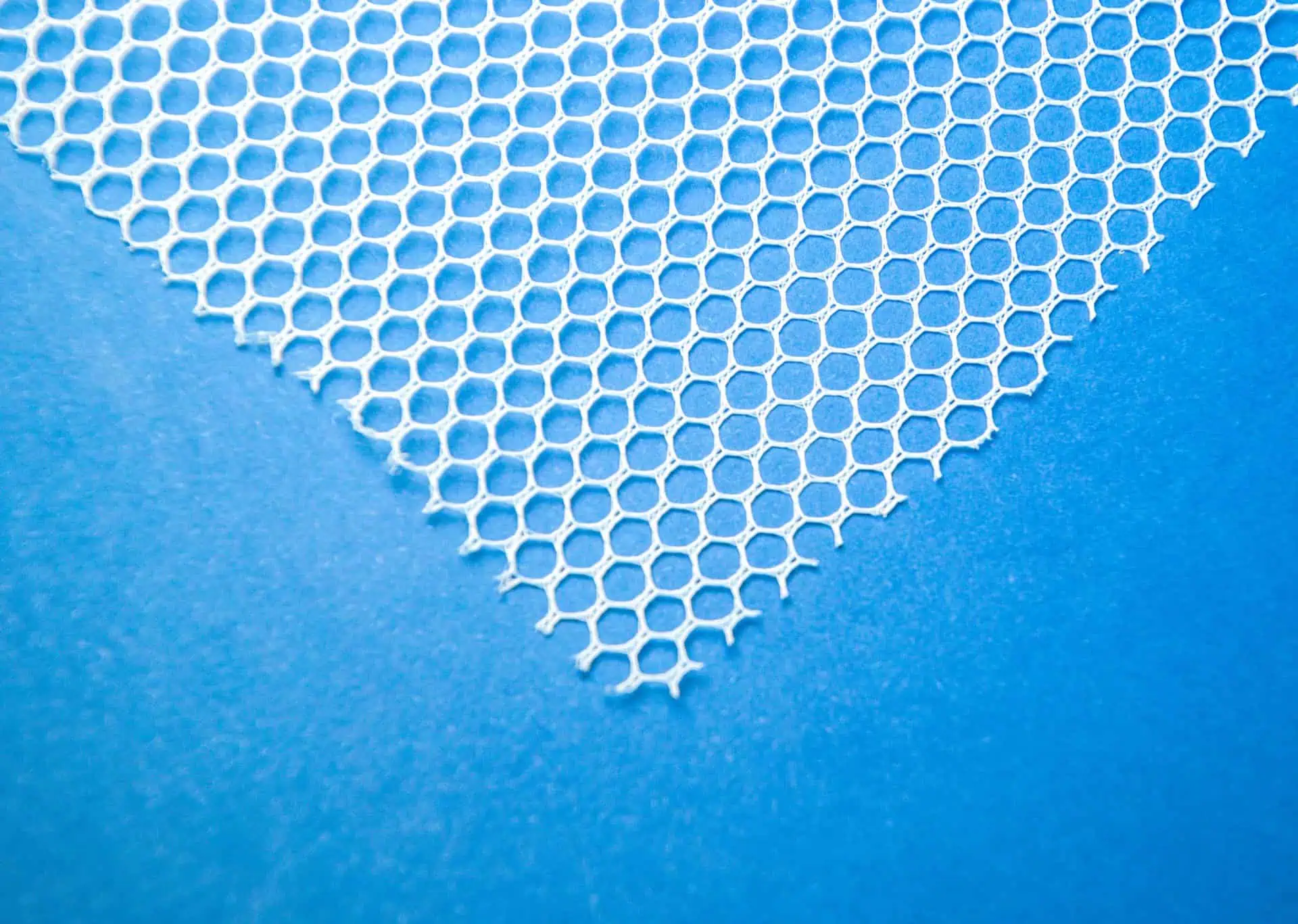Vaginal Mesh: What Can Be Used Instead of Mesh for Prolapse?
- Last Updated: June 12th, 2025

Attorney Jessica Paluch-Hoerman, founder of TruLaw, has over 28 years of experience as a personal injury and mass tort attorney, and previously worked as an international tax attorney at Deloitte. Jessie collaborates with attorneys nationwide — enabling her to share reliable, up-to-date legal information with our readers.
Legally Reviewed
This article has been written and reviewed for legal accuracy and clarity by the team of writers and legal experts at TruLaw and is as accurate as possible. This content should not be taken as legal advice from an attorney. If you would like to learn more about our owner and experienced injury lawyer, Jessie Paluch, you can do so here.
Fact-Checked
TruLaw does everything possible to make sure the information in this article is up to date and accurate. If you need specific legal advice about your case, contact us by using the chat on the bottom of this page. This article should not be taken as advice from an attorney.
Key takeaways:
- Vaginal prolapse happens when muscles and tissues supporting pelvic organs weaken, causing these organs to 'prolapse' into the vagina.
- Risks with using surgical mesh include mesh erosion, infection, pain during intercourse and damage to nearby pelvic organs.
- Alternatives like Gynecare Prolift can provide relief from prolapse symptoms while lowering risk of complications.
Vaginal Mesh: What Can Be Used Instead of Mesh for Prolapse?
Question: What can be used instead of mesh for prolapse?
Answer: Instead of vaginal mesh, procedures such as native tissue repair, biological graft repair, and pubovaginal sling can be utilized to treat pelvic organ prolapse (POP).
On this page, we’ll discuss this question in further depth, an overview of what vaginal prolapse is, the risks and complications of vaginal mesh repair, and much more.
Understanding Prolapse and Methods Used to Treat the Condition (Including Mesh)
These methods use the patient’s own tissue or a graft from a source, such as human or animal tissue, to support the vaginal prolapse.
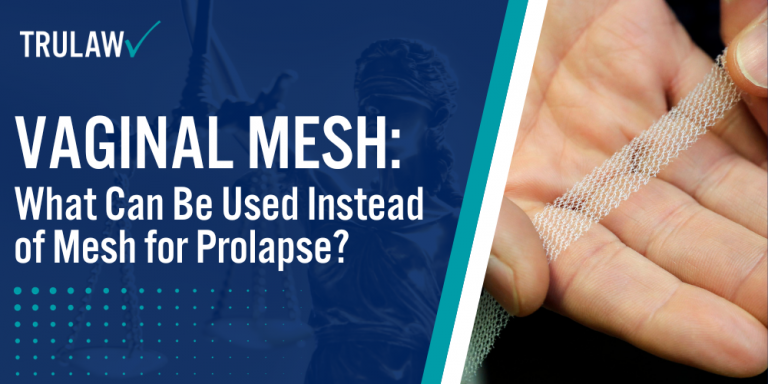
Pelvic organ prolapse is a condition that can be treated with various methods, including surgical mesh.
However, due to potential complications such as pain and infection, alternative treatments like pelvic floor exercises and traditional surgery may be safer and more effective.
If you’ve experienced vaginal mesh complications, injuries, or adverse effects from a transvaginal mesh implant, you may be eligible to file for the Transvaginal Mesh Lawsuit.
Contact the experienced Transvaginal Mesh Lawyers at TruLaw today for a no-obligation consultation.
We’re here to help you seek the compensation you deserve.
Table of Contents
Understanding Vaginal Prolapse
Vaginal prolapse is a pelvic floor disorder that occurs when the muscles and connective tissues supporting the pelvic organs weaken, causing these organs to descend into the vaginal canal.

This condition can be triggered by numerous risk factors such as childbirth, menopause, aging, heavy lifting, or chronic constipation.
Causes of Vaginal Prolapse
Vaginal prolapse can occur due to various reasons such as childbirth, menopause, aging, and obesity.
Women who have given birth vaginally are at a higher chance of developing this condition because the muscles and tissues supporting the pelvis get weakened during delivery.
Menopause also contributes to vaginal prolapse because estrogen, which maintains strength in your pelvic muscles declines during menopause.
These symptoms often include a feeling of heaviness in the pelvic area, as though something is falling out of the vagina.
Other indications can range from urinary problems such as frequent urination or an urge to urinate, pelvic pain or pressure, difficulty with bowel movements, and uncomfortable sexual intercourse due to dyspareunia.
The severity of these symptoms often relates directly to the extent of the prolapse and could impact women’s everyday lives if left untreated.
Impact on Daily Life
Experiencing a vaginal prolapse disrupts a woman’s everyday routine.
It triggers discomfort and fosters embarrassment, limiting social engagement and daily activities.
Physical discomfort may include pain during bowel movements or sexual activity.
This can lead to stress which affects the overall quality of life and well-being.
Many women suffering from pelvic organ prolapse face urinary incontinence, requiring constant access to washroom facilities, thus constraining freedom of movement and activity participation.
Treatment Options for Vaginal Prolapse
The primary focus will be on contrasting transvaginal mesh alternatives, including traditional mesh repair options like native tissue repair or the use of a pessary.
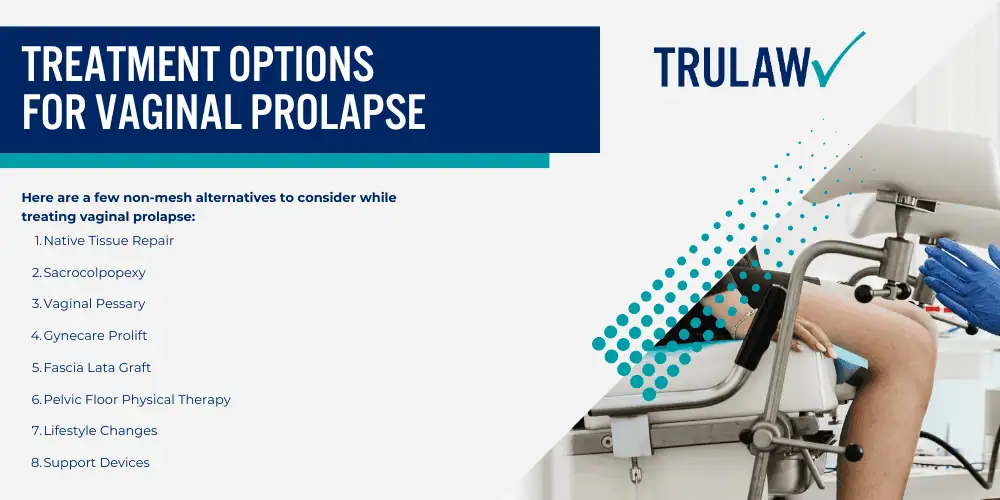
Vaginal Mesh Repair
Vaginal mesh repair, a widely employed method to address pelvic organ prolapse and stress urinary incontinence, involves the use of surgical mesh introduced through the vagina.
This technique has sparked controversy due to its potential complications such as mesh erosion, dyspareunia (pain during intercourse), hematomas, and further instances of urinary incontinence.
It’s crucial to note that while surgical mesh is considered a permanent solution for these conditions, it brings an increased risk of mesh-related issues.
Concerns over these occurrences have resulted in numerous legal actions taken by women who suffered post-surgical complications from vaginal mesh procedures.
Non-mesh Procedures
Several options exist for non-mesh procedures in treating vaginal prolapse.
Here are a few non-mesh alternatives to consider while treating vaginal prolapse:
- Native Tissue Repair: This is an alternative to using synthetic mesh where the body’s own tissues are utilized to repair the weakened vaginal wall.
- Sacrocolpopexy: A procedure often performed laparoscopically, sacrocolpopexy involves the use of your own tissue or a biologic graft to correct pelvic organ prolapse.
- Vaginal Pessary: This is a device inserted into the vagina to support sagging pelvic organs. It’s a treatment option that does not require surgery and can be removed and cleaned regularly.
- Gynecare Prolift: This method uses specially designed medical fabric inserts, not mesh, to provide added support and stability to sagging pelvic organs.
- Fascia Lata Graft: In this process, a patient’s own fascia lata muscle tissue from their thigh is used as a graft for surgical management of pelvic floor disorders.
- Pelvic Floor Physical Therapy: Therapists trained in this specialty help women strengthen their pelvic floor muscles through exercises and other treatments.
- Lifestyle Changes: These may include dietary modifications, weight management, avoiding heavy lifting, and performing regular Kegel exercises to strengthen the pelvic floor muscles.
- Support Devices: These items assist in managing symptoms; they offer temporary relief without requiring any surgical procedure but need regular adjustment.
Risks and Complications of Vaginal Mesh Repair
A common complication, it involves the surgical mesh breaking through the vaginal epithelium or wall.
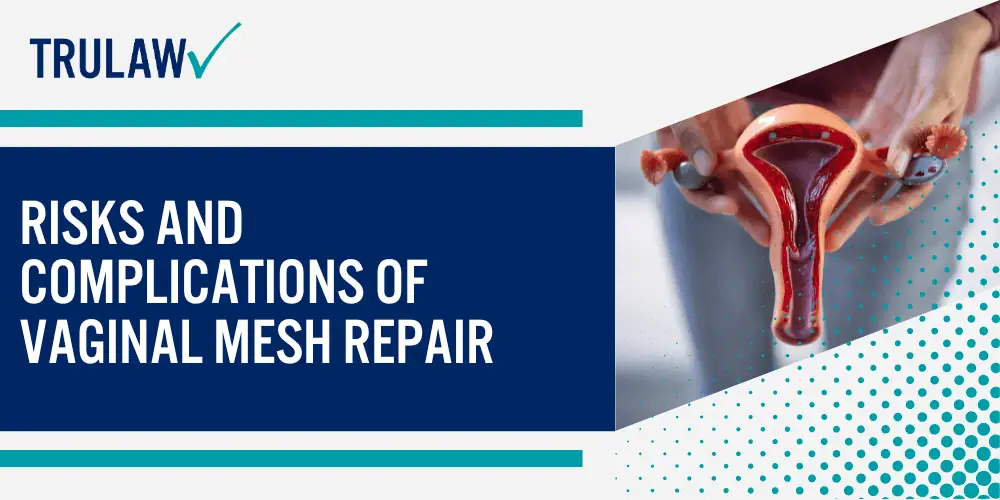
Mesh Erosion
Mesh erosion represents a significant concern in vaginal mesh repair procedures.
This often leads to troubling symptoms such as irregular bleeding, unusual discharge, pelvic pain and swelling, along with bladder and bowel issues.
In severe instances of mesh erosion, additional treatment becomes necessary to rectify these complications.
The most frequently reported issue specific to mesh use is indeed this unwelcome occurrence of erosion into the vagina following surgery for pelvic organ prolapse or stress urinary incontinence.
Infection
Infections pose a serious risk in the aftermath of vaginal mesh surgeries.
These can be a standalone complication or may contribute to other complications such as erosion, pain during intercourse, and damage to pelvic organs.
Mesh-related infections may range from causing mild discomfort to inflicting debilitating pain for patients undergoing transvaginal mesh surgery used in pelvic organ prolapse repair.
A thorough assessment of patient’s health condition is necessary before considering surgical treatment options like this.
Medical practitioners always strive to mitigate these risks while adhering strictly to procedural norms and computer-assisted minimally invasive methods where applicable.
Pain During Intercourse
Mesh complications from pelvic floor reconstructive surgery often lead to discomfort during sexual activities.
This issue stems primarily from mesh exposure or erosion, a prevalent complication of this treatment option.
It manifests as an uncomfortable sensation that can escalate into pronounced pain during intercourse over time.
Being mindful of these symptoms is crucial, as they may indicate the need for immediate medical intervention.
The process often involves diagnosis by qualified professionals and implementation of appropriate treatments designed to manage such issues effectively.
Choosing non-mesh procedures for vaginal prolapse repair could circumvent these problems, offering relief without the risk of mesh-related difficulties.
Pelvic Organ Damage
Pelvic organ damage refers to the impairment of pelvic organs like the bladder, uterus, and rectum.
This can result from conditions like pelvic floor disorders or complications arising from procedures such as vaginal mesh repair for treating prolapse.
The use of surgical mesh can lead to severe consequences, including tearing of organs, which is a form of pelvic organ damage.
Such outcomes highlight the necessity for safer alternatives in treating pelvic organ prolapse without risking additional harm to other organs.
Surgery should ideally strengthen weakened pelvic muscles while reducing potential problems associated with synthetic materials – especially given that most surgical mesh complications comprise erosion and infections beside organ perforation or tearing.
What Can Be Used Instead of Mesh for Vaginal Prolapse?
Native tissue repair stands as a viable alternative to the use of vaginal mesh in prolapse surgeries.
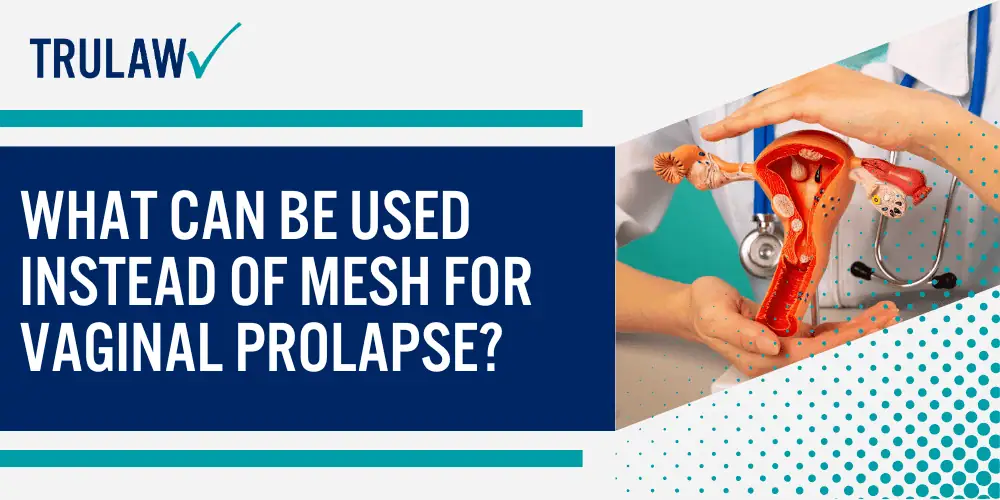
Native Tissue Repair
This traditional method utilizes the patient’s own tissues to hoist prolapsed organs and reconstruct pelvic organ support.
Despite its high recurrence rates, it remains a widespread choice due to its lower risk of complications when compared to synthetic materials like mesh.
However, recent literature searches reveal limited safety data on the medium-term efficacy of native tissue repair relative to partially absorbable mesh kits in treating pelvic organ prolapse.
Gynecare Prolift
Gynecare Prolift, a mesh system introduced in 2005, aims to provide relief for women suffering from genital prolapse.
Despite its initial popularity, this treatment has sparked controversy with reports of associated morbidity and functional mid-term outcomes.
The FDA has since banned the Gynecare Prolift mesh alongside other transvaginal meshes in response to rising concerns over potential complications.
Because of these issues, some healthcare providers have avoided using it altogether.
Alternatives like native tissue repair and grafts are becoming more common as they present fewer risks while still effectively treating vaginal prolapse.
Sacrocolpopexy
Sacrocolpopexy is a procedure that plays a crucial role in the treatment of pelvic organ prolapse.
Surgeons conduct this abdominal surgery to lift and secure the prolapsed organs, restoring them back to their original position.
It has garnered attention due to its promising results, displaying lower complication rates compared to transvaginal mesh surgeries.
A comparison of outcomes revealed sacrocolpopexy with mesh outperformed vaginal repairs with native tissue.
However, there’s ongoing discussion on whether to use mesh or not during the procedure.
For those who are exploring alternatives for mesh-related procedures, sacrocolpopexy without mesh proves an effective option!
Thus it stands as one of the potential solutions for addressing vaginal prolapse concerns.
Vaginal Pessary
A vaginal pessary is a non-surgical treatment option for pelvic organ prolapse.
This device, often made of silicone, gets inserted into the vagina to support structures that are sagging or dropping.
It offers a practical and minimally invasive alternative to mesh procedures.
Pessaries come in various shapes and sizes to adequately fit each individual woman’s body and condition.
They help alleviate symptoms associated with prolapse by providing additional support to the weakened pelvic muscles and tissues.
The successful fitting of a pessary correlates significantly with better therapeutic outcomes, as it can restore normal physical functionality while reducing discomfort during daily activities like bowel movements or walking.
Benefits of Non-Mesh Procedures
These options can support weakened pelvic muscles and links without using synthetic materials, making them a popular choice for women with pelvic organ prolapse and stress urinary incontinence.

Lower risk of complications
Non-mesh procedures present a lower risk of complications.
Surgical mesh, especially when used to repair pelvic organ prolapse through the vagina, often leads to higher risks of complications.
Problems can range from infection and pain during intercourse to potentially damaging nearby pelvic organs.
However, non-mesh procedures such as native tissue repair offer alternatives that help avoid these issues.
This reduces not only physical discomfort but also alleviates mental stress associated with postoperative complications.
So it’s clear that opting for non-mesh treatments could mean a safer path towards recovery from vaginal prolapse.
Faster recovery time
Non-mesh procedures offer a significant advantage in terms of recovery speed after pelvic floor reconstructive surgery.
These treatments, such as native tissue repair or sacrocolpopexy, promote prompt healing due to the use of the body’s own tissue instead of synthetic materials like mesh.
Patients usually notice an improvement in symptoms shortly after their procedure and can go back to their normal routines much sooner than with traditional mesh surgeries.
The less invasive nature of these alternatives results in fewer post-surgery complications and lowers the overall recovery time, getting patients back on their feet faster.
Lower cost
Opting for non-mesh procedures can significantly lower the financial burden of dealing with prolapse.
The expenses linked to vaginal mesh include not only the initial surgery but also potential follow-up procedures due to complications like mesh erosion or infection.
On top of this, ongoing pain medication and therapy sessions may add to costs over time.
Non-mesh alternatives generally involve a one-time expense without the added financial risk associated with possible complications, saving dollars in the long run.
No risk of mesh-related complications
Mesh complications can include mesh erosion, infection, pain during intercourse, and pelvic organ damage.
These risks are not present in non-mesh procedures for treating vaginal prolapse.
Using native tissue repair or other alternatives to mesh significantly reduces the chances of experiencing these complications post-surgery.
The absence of a foreign body like synthetic mesh in your body means fewer opportunities for your system to react adversely.
Non-mesh treatments offer peace of mind by completely eliminating the risk related to mesh use without compromising the effectiveness of the treatment.
It’s one less thing you have to worry about as you heal from surgery and regain control over your daily life.
Choosing the Right Treatment Option for You
Before deciding on a treatment option for your vaginal prolapse, it is crucial to discuss with your healthcare provider about the variety of non-mesh procedures available, their success rates and learn which one will best cater to your individual needs and concerns.

Discussing with your doctor
Open communication with your healthcare provider helps tailor a treatment plan that meets your specific needs.
Your doctor can elucidate the various non-mesh procedures available, answer questions, and offer guidance on potential outcomes and risks.
This dialogue is crucial to making an informed decision about surgical options for pelvic organ prolapse.
With a discussion on lifestyle changes and managing symptoms using support devices, your healthcare provider can guide you through alternatives to mesh surgery such as native tissue repair or moving towards minimally invasive surgeries like laparoscopic procedures.
Considering your individual needs and concerns
Evaluating your personal health status and lifestyle preferences is critical in choosing a treatment option for pelvic organ prolapse.
Each procedure has its own set of risks, benefits, recovery time, and success rates.
Not all treatments may be suitable for everyone; some may not respond well to certain procedures due to underlying conditions or age.
Personal comfort with the procedure also matters as it might affect your emotional well-being post-surgery.
Discussing these aspects openly with your doctor will help create a personalized treatment plan that fits best with your unique needs and concerns.
This open communication bolsters trust between you and your healthcare provider, fostering a collaborative environment where decisions are made keeping patient welfare at the forefront.
Understanding the success rates of different procedures
Various procedures for treating vaginal prolapse have differing success rates.
The effectiveness of the treatments largely depends on factors such as the severity of the condition, overall health status, and medical history of the patient.
Vaginal surgery with mesh to correct apical prolapse often has a higher complication rate when compared with other techniques.
Transvaginal mesh is commonly used to treat stress urinary incontinence but only after non-surgical treatment options haven’t yielded satisfactory results.
Despite its widespread use, this method has been linked to higher rates of mesh-related problems.
In contrast, abdominal pelvic organ prolapse (POP) surgery utilizing mesh appears to have lower rates of complications related to the mesh when stacked against transvaginal POP surgeries.
It’s important that these variations in success rates are taken into account by patients while considering their treatment options for vaginal prolapse and should be discussed extensively with their healthcare provider before proceeding.
What to Expect During and After Non-Mesh Procedures
Understanding the process and recovery of non-mesh procedures is crucial for patients considering alternatives to vaginal mesh.
During these surgical methods, like sacrocolpopexy or native tissue repair, your surgeon will lift and secure your prolapsed organ back into place without using synthetic materials.
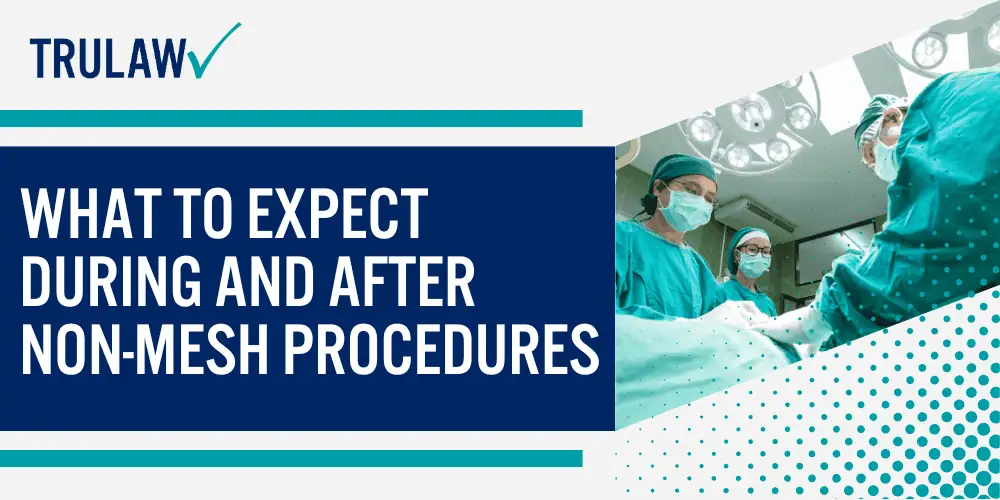
The recovery timeline can vary depending on the exact procedure conducted but typically sees patients returning to their normal activities faster than mesh surgeries.
Furthermore, potential side effects might include mild discomfort and manageable pain; however, they are generally less severe compared to complications related to mesh treatments such as erosion or infection.
Surgery process
Surgeons perform non-mesh procedures under general or spinal anesthesia.
The process begins with making incisions in the lower abdomen or vagina, depending on the type of procedure chosen.
Medical professionals then use sutures to stitch and strengthen weakened pelvic tissues, effectively lifting prolapsed organs back to their original position.
After the repair, surgeons close up these incisions using additional stitches that eventually dissolve over time.
This surgical process’s success greatly depends on precise execution by an experienced team of healthcare providers.
Recovery timeline
Your body starts to heal right after the completion of a non-mesh procedure.
It’s critical for patients to be patient and follow their surgeon’s post-operative care instructions for optimal healing.
Many individuals may start feeling better within two weeks following surgery, but it varies from person to person.
Complete healing typically takes around six weeks.
During this period, strenuous physical activities and sexual intercourse should be avoided to prevent complications.
Most people return to work or normal daily routines between two and four weeks post-surgery, depending on the type of job or activity level required.
Potential side effects
Pelvic floor repair without mesh may still entail some side effects.
Among the most common are discomfort, infection, and bleeding during the anticipated recovery period.
In particular, procedures such as native tissue repair could potentially result in tightened vaginal muscles which can lead to painful intercourse.
Beyond physical side effects, non-mesh procedures might also present psychological implications.
Anxiety or depression may set in due to prolonged recovery times or dissatisfaction with treatment outcomes.
As every patient’s situation is unique, it’s crucial for them to discuss all potential risks and side effects with their healthcare provider before proceeding with any treatment option.
Other Non-Surgical Treatment Options for Vaginal Prolapse
Exploring the benefits and practice of non-surgical solutions such as pelvic floor physical therapy, lifestyle modifications and managing symptoms with support devices can offer significant relief for women dealing with vaginal prolapse.
Pelvic Floor Physical Therapy
Pelvic floor physical therapy is an effective nonsurgical approach to treating pelvic organ prolapse and stress incontinence.
This therapy involves targeted exercises designed to strengthen the muscles of the pelvic floor.
By improving muscle tone and coordination, individuals often experience a reduction in uncomfortable symptoms, such as urinary leakage or sensations of pressure or pain related to prolapse.
While it requires regular practice, many find relief with this method combining breathwork, movement exercises, and lifestyle habits to improve overall pelvic health.
Lifestyle Changes
Adopting healthier habits forms a crucial part of managing pelvic organ prolapse without surgery.
This involves maintaining a healthy weight to minimize pressure exerted on the pelvic floor muscles.
Regular physical activity, such as walking and gentle exercising, further strengthens these muscles and enhances overall health.
A balanced diet rich in fiber can prevent constipation, hence reducing strain during bowel movements that might exacerbate prolapse conditions.
Moderating caffeine and fluids could help with urinary incontinence issues.
Quitting smoking also significantly improves pelvic muscle tone due to better oxygen supply to the tissues, thereby aiding in prolapse management.
These lifestyle changes are key facets of any successful treatment strategy for those experiencing symptoms of this condition.
Managing Symptoms with Support Devices
Support devices play a vital role in managing symptoms of vaginal prolapse.
They work by offering the much-needed support to the vaginal walls and pelvic organs, thus helping prevent further prolapse and providing relief from discomfort.
One commonly used device is a pessary.
A pessary is an easily removable device that gets inserted into the vagina to help prop up pelvic organs.
While these tools can considerably alleviate discomfort, they aren’t just limited to physical support.
Support devices also align well with other non-surgical treatment options such as hormone therapy, lifestyle changes, and particularly pelvic floor exercises or physiotherapy.
These combined measures can lead to substantial improvements in overall comfort and quality of life for those dealing with vaginal prolapse.
Conclusion: Making the Best Decision for Your Health and Well-Being
Understanding your options is essential when dealing with vaginal prolapse.
Non-mesh alternatives provide various benefits, including a lower risk of complications and faster recovery times.
Discussing these procedures with your doctor empowers you to make the optimal decision for your health and overall well-being.
Transvaginal Mesh Lawsuit Frequently Asked Questions
-
What can be used instead of mesh for prolapse?
There are several alternatives to using mesh for the treatment of prolapse, including non-mesh options and surgical procedures.
Here are some of the alternatives can be used instead of mesh to treat pelvic organ prolapse:
- Pelvic floor exercises: These exercises can help strengthen the pelvic floor muscles and support the organs in the pelvis.
- Pessaries: These are devices inserted into the vagina to support the pelvic organs.
- Colporrhaphy: This is a surgical procedure that involves stitching the weakened pelvic floor muscles together to provide support for the pelvic organs.
- Sacrocolpopexy: This surgery involves using a person’s own tissue or a biologic graft to provide support to the vaginal wall.
-
What are the risk factors for developing pelvic organ prolapse?
Each of these factors can contribute to the weakening of the muscles and tissues that support the pelvic organs, leading to prolapse.
The risk factors for developing pelvic organ prolapse include:
- Having one or more vaginal births
- Being older when you have your first baby
- Giving birth to a large baby
- Aging
- Obesity
- Prior pelvic surgery
- Chronic constipation or often straining during bowel movements
- Family history of weak connective tissue
If you’ve experienced vaginal mesh complications, injuries, or adverse effects from a transvaginal mesh implant, you may be eligible to file for the Transvaginal Mesh Lawsuit.
-
Are there non-surgical alternatives to transvaginal mesh for prolapse?
Yes, there are non-surgical alternatives to transvaginal mesh for prolapse.
These include:
- Pelvic floor exercises: These can help strengthen the muscles that support the pelvic organs.
- Pessaries: These devices are inserted into the vagina to support the pelvic organs.
If you’ve experienced vaginal mesh complications, injuries, or adverse effects from a transvaginal mesh implant, you may be eligible to file for the Transvaginal Mesh Lawsuit.
Contact the experienced Transvaginal Mesh Lawyers at TruLaw today for a no-obligation consultation.
We’re here to help you seek the compensation you deserve.
-
What is transvaginal mesh made from?
Transvaginal mesh is typically made from synthetic materials, particularly polypropylene.
Here’s what you need to know about it:
- Polypropylene is a type of plastic that is often used in medical procedures.
- It is used in the production of transvaginal mesh due to its ability to provide support to weakened or damaged internal tissues.
- While it is commonly used, it has also been associated with various complications, leading the FDA to halt the sale of transvaginal mesh devices used for the repair of pelvic organ prolapse.
-
Are there alternatives to polypropylene for transvaginal mesh?
While polypropylene is the most commonly used material for transvaginal mesh, there are alternatives available.
Here are some key points about these alternatives:
- Some transvaginal mesh products are made from biological materials, such as animal tissue.
- These alternative materials can provide the same level of support as synthetic materials, but may have fewer associated complications.
- However, the use of any type of transvaginal mesh — whether synthetic or biological — carries its own set of risks and potential complications.

Managing Attorney & Owner
With over 25 years of legal experience, Jessica Paluch-Hoerman is an Illinois lawyer, a CPA, and a mother of three. She spent the first decade of her career working as an international tax attorney at Deloitte.
In 2009, Jessie co-founded her own law firm with her husband – which has scaled to over 30 employees since its conception.
In 2016, Jessie founded TruLaw, which allows her to collaborate with attorneys and legal experts across the United States on a daily basis. This hypervaluable network of experts is what enables her to share the most reliable, accurate, and up-to-date legal information with our readers!
Additional Transvaginal Mesh Lawsuit resources on our website:
Here, at TruLaw, we’re committed to helping victims get the justice they deserve.
Alongside our partner law firms, we have successfully collected over $3 Billion in verdicts and settlements on behalf of injured individuals.
Would you like our help?
At TruLaw, we fiercely combat corporations that endanger individuals’ well-being. If you’ve suffered injuries and believe these well-funded entities should be held accountable, we’re here for you.
With TruLaw, you gain access to successful and seasoned lawyers who maximize your chances of success. Our lawyers invest in you—they do not receive a dime until your lawsuit reaches a successful resolution!
AFFF Lawsuit claims are being filed against manufacturers of aqueous film-forming foam (AFFF), commonly used in firefighting.
Claims allege that companies such as 3M, DuPont, and Tyco Fire Products failed to adequately warn users about the potential dangers of AFFF exposure — including increased risks of various cancers and diseases.
Depo Provera Lawsuit claims are being filed by individuals who allege they developed meningioma (a type of brain tumor) after receiving Depo-Provera birth control injections.
A 2024 study found that women using Depo-Provera for at least 1 year are five times more likely to develop meningioma brain tumors compared to those not using the drug.
Suboxone Tooth Decay Lawsuit claims are being filed against Indivior, the manufacturer of Suboxone, a medication used to treat opioid addiction.
Claims allege that Indivior failed to adequately warn users about the potential dangers of severe tooth decay and dental injuries associated with Suboxone’s sublingual film version.
Social Media Harm Lawsuits are being filed against social media companies for allegedly causing mental health issues in children and teens.
Claims allege that companies like Meta, Google, ByteDance, and Snap designed addictive platforms that led to anxiety, depression, and other mental health issues without adequately warning users or parents.
Transvaginal Mesh Lawsuits are being filed against manufacturers of transvaginal mesh products used to treat pelvic organ prolapse (POP) and stress urinary incontinence (SUI).
Claims allege that companies like Ethicon, C.R. Bard, and Boston Scientific failed to adequately warn about potential dangers — including erosion, pain, and infection.
Bair Hugger Warming Blanket Lawsuits involve claims against 3M — alleging their surgical warming blankets caused severe infections and complications (particularly in hip and knee replacement surgeries).
Plaintiffs claim 3M failed to warn about potential risks — despite knowing about increased risk of deep joint infections since 2011.
Baby Formula NEC Lawsuit claims are being filed against manufacturers of cow’s milk-based baby formula products.
Claims allege that companies like Abbott Laboratories (Similac) and Mead Johnson & Company (Enfamil) failed to warn about the increased risk of necrotizing enterocolitis (NEC) in premature infants.
Here, at TruLaw, we’re committed to helping victims get the justice they deserve.
Alongside our partner law firms, we have successfully collected over $3 Billion in verdicts and settlements on behalf of injured individuals.
Would you like our help?
